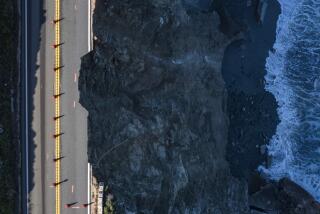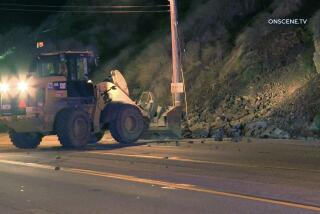Canyon Commute Is Uphill Fight
- Share via
For Josh Mankiewicz, driving to his job in Burbank on Wednesday, a gloriously sunny day with no sign of rain, was nonetheless a recipe for “a road rage headache.”
Mankiewicz, a correspondent for “Dateline NBC,” left his home in Beverly Hills expecting a straightforward commute on streets to work at the network’s Burbank studios. Half an hour, maximum, he thought.
“I had to take five different detours to get to work today. The city’s an obstacle course. This should be an Olympic event,” he said.
Coldwater Canyon Drive was closed because of damage from the storm. He took Sunset -- “not a perfect route unless you’re club crawling” -- to get to the Hollywood Freeway at Franklin Avenue.
“Traffic was jammed there. It was like a Stones concert was going on,” Mankiewicz said. On Barham Boulevard, his path was blocked by a city truck “the size of a naval destroyer” drilling holes into the road. Roadblocks and tape barred streets like crime scenes.
He got to work more than an hour late, barely making a meeting.
Mankiewicz and thousands of other Los Angeles motorists were discovering that the commute in some parts of the city wasn’t getting much better despite the end of the rain. Several key canyon roads across the Hollywood Hills -- including Coldwater Canyon, Laurel Canyon Boulevard and Mulholland Drive -- were closed Wednesday for the third straight day, blocking a key route between the Westside and the San Fernando Valley.
City crews were working to repair more than 600 potholes, said Cora Jackson-Fossett, a spokeswoman for the Public Works Department. The city hopes to have most of them plugged by late Sunday, she said.
Dozens of county and city roads remain partly or totally closed because of mudslides, downed trees, massive boulders and other damage.
City crews were trying to open Coldwater Canyon Drive and Laurel Canyon Boulevard by today’s morning commute, though they would do so only with a lowered speed limit and were still recommending that people use other routes.
Mulholland Drive will remain closed to nonresidents longer because rain caused greater structural damage to the road foundation and there is concern about further mudslides. Portions of Topanga Canyon Boulevard will be shut until the remnants of a massive boulder are removed.
The road closures have added extra congestion to the Ventura and San Diego freeways -- for good reason.
“The Santa Monica Mountains form the barrier between the Valley and the metro area, and the biggest traffic bottleneck in the city is created because of limited access,” said John Fisher, assistant manager for the Los Angeles Department of Transportation.
The canyon roads “are very heavily traveled, but narrow two-lane streets. Many years ago, it was documented that Coldwater Canyon carried more traffic for any street its size than any [other] street in America,” Fisher said. “It’s like water; traffic goes wherever it can.”
Santo D’Arienzo said he knows all about that. His normally half-hour drive to the Warner Bros. Studio in Burbank from Winnetka almost doubled Wednesday morning.
“The freeway was just a parking lot. I was driving 5 to 10 miles per hour until I got past the 405,” said D’Arienzo, 34. “I left at the normal time, so I got nailed by the traffic.”
Until Wednesday, some schools were closed to spare parents, children and faculty from harried commutes. The private Harvard-Westlake School closed until then to “err on the side of safety and sanity,” said Assistant Headmaster John Amato.
“We didn’t have the horror stories because the school was closed,” Amato said. “We have a fair number of kids -- mostly the older ones -- who drive to school. We didn’t want to put them in jeopardy.”
Up in the muddied canyons, residents such as Harriet Matthey were assessing the damage to their neighborhoods and acting as volunteer traffic cops for wayward motorists.
Walking along a mud-caked Woodstock Road, near where Laurel Canyon Boulevard and Mulholland Drive combine to form a bottleneck for a stream of cars, Matthey shouted at a neighbor in a sedan.
“You have to go around,” said Matthey, who was walking her neighbor’s cocker spaniel and trying to forget about the neighbor’s eucalyptus tree that had crushed two of her palm trees.
A parking enforcement officer stationed nearby chimed in, “Sorry sir, the road is collapsing.”
Indeed, only a five-minute walk farther revealed a crumbled side of Woodstock Road that had toppled down a 100-foot slope into the back of a home. The white, metal guardrail lay twisted off the end of the street.
“Their whole first floor is covered in mud,” Matthey said, looking down at the distant neighbor.
Meanwhile, traffic exiting the San Fernando Valley and headed for Hollywood was being diverted away from the southbound side of Laurel Canyon and onto Woodrow Wilson Drive. Rocks and slippery roads greeted the confused drivers headed for Mulholland Drive.
“The drivers seem pretty frustrated,” said Matthey, who has lived in the canyon for 19 years. “They’re driving through fast, splashing water.”
Just east was Lulu Glen, a steep road where gallons of water streamed at least 3 inches high into a gutter.
An adjacent home was flooded with mud over the weekend. Workers carried plastic buckets of sludge out and dumped it onto a flatbed truck.
Resident Jonathan Brown, taking a walk with his father-in-law, said there were benefits to the closure of Woodstock and nearby Laurel Canyon, which are usually inundated with traffic from both sides of the “hill.”
“I got to walk on the street for the first time,” he said. “I hope the city takes this opportunity to build some speed bumps. It’s really bad in the evenings when people are commuting home.”
The after-effects of the storm still had people on edge, and city and county crews were working to ensure that roads and hillsides were safe.
Five homes in the 7800 block of Woodrow Wilson Drive in the city’s Mount Olympus area were evacuated because there was evidence of soil movement in the hill.
“It appears from what the geologists say that the soil is moving along a bedrock and could settle within a couple of days,” said Jim Wells, a spokesman for the Los Angeles Fire Department. “But in the meantime, we’re advising people to stay out.”
Officials also warned visitors to stay out of the water at beaches across Southern California, where piles of trash and debris have formed towers on the shoreline. Lifeguards warned against people going scavenging, saying rattlesnakes might have washed down to the shore.
More than 70 beaches across the state were closed because of high bacteria levels in the water, due largely to sewage spills and urban runoff.
Mankiewicz, meanwhile, was dreading today’s commute, comparing his experience Wednesday to being a character in a tense TV thriller.
“It’s like an episode of ‘24,’ ” he said. “It’s like whatever you’re doing is not going to work. You have to change plans.”
More to Read
Sign up for Essential California
The most important California stories and recommendations in your inbox every morning.
You may occasionally receive promotional content from the Los Angeles Times.















